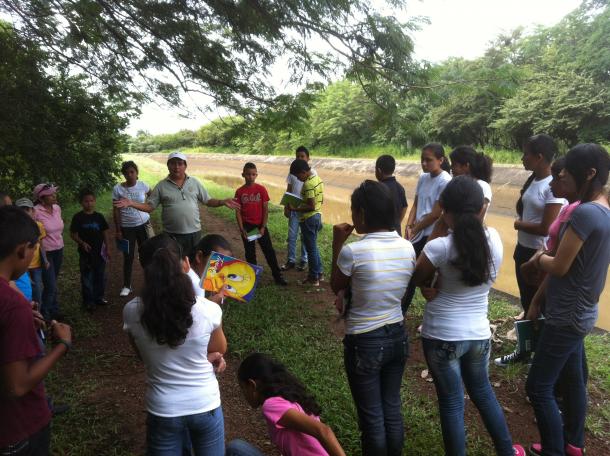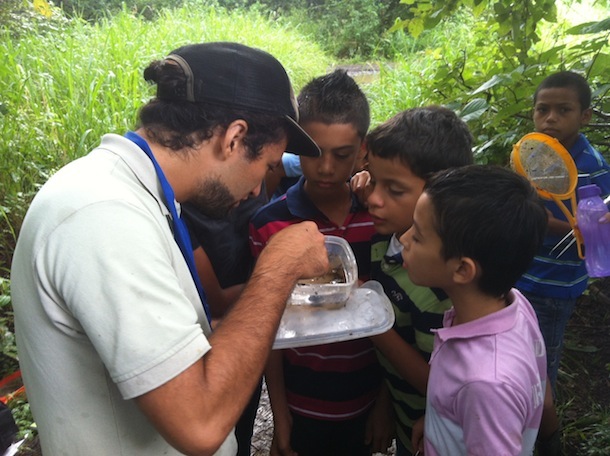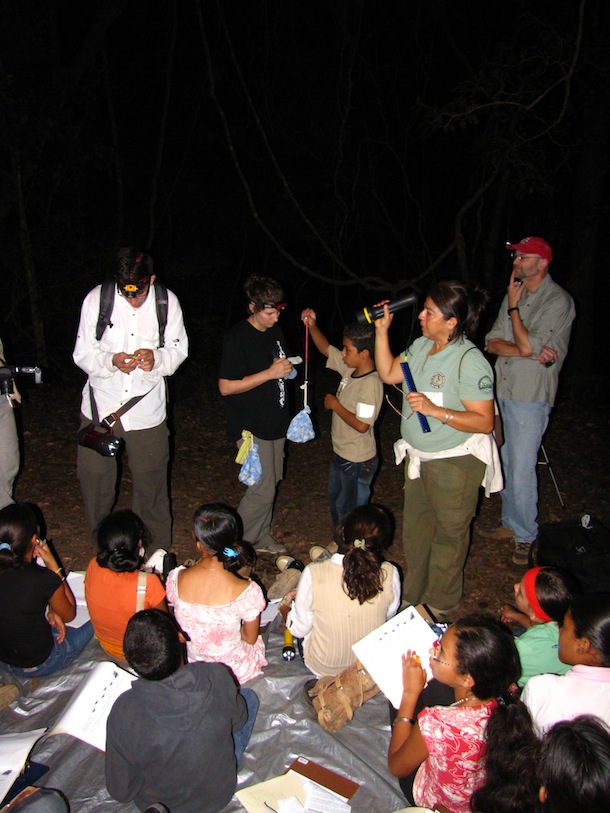Programa de Educación Biológica (PEB)
The PEB is a formal field-taught natural history and science education program for elementary school children (4th, 5th and 6th grades) developed first by Area de Conservación Guanacaste (ACG) in 1985 with additional financial support from ACG’s partner non-profit group, the Guanacaste Dry Forest Conservation Fund (GDFCF). Thirteen full time PEB teachers partner with the 53 elementary schools surrounding the ACG protected area. They introduce students to their natural heritage in the field and in circumstances intended to be pleasantly remembered for the rest of their lives. The student families pay nothing today, but will "repay" some day with their knowledge and votes in favor of ACG and wild nature.
With four distinct ecosystems and one of the most concentrated assemblages of resident and migrant species on the planet (500,000 estimated), ACG is a terrific outdoor teaching laboratory. Six days per student per year, on site in nature, is supplemented by classroom style presentations from PEB teachers. PEB annually brings more than 2,500 students into ACG and has become their link between wild nature and the formal Costa Rican education system and the world of the internet.
Although Costa Rica’s biodiversity has been widely touted as a globally significant “public good” deserving protection, the reality is that it won’t survive without a vigorous, well-informed local, national and international constituency. As Dr. Daniel Janzen, an ACG founder and long time tropical biodiversity researcher has said,
“How are you ever going to get people to see the wild world as anything other than an object to be pushed away or chopped up unless they come to have some personal relationship with it?”

From the 1985 beginning, Janzen, Hallwachs and others recognized the need for “biocultural restoration” with the same imperative as restoration of ACG’s physical and ecological landscape.
About 80% of the ACG landscape has been directly impacted by 400+ years of clearing, hunting, logging, burning, grazing, and intensive subsistence agriculture. (The ACG core was originally the third Spanish colonial ranch established in Costa Rica in about 1580.) The economic history of surrounding communities was largely built on resource extraction. While most of the big cattle ranches and lumber mills are gone, much of the landscape surrounding ACG is still dominated by intensive agriculture (rice, bananas, pineapples, oranges, coffee, low grade pasture) — what some call the "agroscape" — and occupied by a dwindling rural population, every day more excluded from wild nature. The challenge is to integrate ACG’s restoring and protected landscape into the mosaic of the managed agroscape. As ACG Research Co-coordinator Róger Blanco Seguro has written,
“…PEB is restoring the biological understanding of its neighbors with the aim of creating a community that can make better-informed environmental decisions in the future."
A key goal of PEB is to improve future decision-making through local understanding rather than to sell a particular ideology delivered from afar. This is what has given the PEB program local credibility, along with giving the next generation a glimpse of the nature that their grandparents knew.
Opportunities Going Forward — the PEB is Not Just for Children
PEB was started as a deliberate means of creating bioliteracy within a rapidly urbanizing resident generation, so that the task of protecting and maintaining ACG into the future does not simply rise and fall on the whims of national and international governments and distant donors. However, the job is ongoing and always will be. While PEB to date has targeted elementary school children, ACG and PEB outreach programs have been successful with high school students, teachers and parents. PEB has three long term desires: a) develop extensive programs with nearby high schools and other community groups, b) more fully integrate the ACG Sector Marino (marine sector) into the PEB curriculum, and c) improve connectivity between the neighboring schools and biodiversity management programs underway throughout ACG by dedicated resident science-based biodiversity managers (currently, mostly parataxonomists).
A signature benefit of the PEB program is its hands-on, place-based curriculum that is based in the living laboratory of ACG itself, one of the world’s greatest biodiversity resources. Program feedback repeatedly expresses desire for more field trips and expansion to other grades and groups, expansion that is very much possible except for the lack of funds. PEB runs on in-kind government staff time and some operations (e.g., diesel and tires for the school buses), a shoestring supplies and repairs budget from small donations from GDFCF, and donations from a local rice farm and hotel development. Yet, it is one of the most widely respected components of the ACG model, and certainly the most powerful form of “protection” that ACG has for itself. PEB has been studied and replicated in Great Smoky Mountains National Park, Panama, Honduras, and other parts of the world. However, with additional resources PEB can continue to lead and expand this remarkable bioliteracy model in the following ways:
- Add a core group of high schools and develop an age-appropriate curriculum that builds on the lessons learned at the elementary school level (including reaching students and even parents who were not exposed at younger ages).
- Increase the frequency of interactions between the schools and the PEB program. While PEB began with 8 visits per student per year, today, due to high demand, each student can visit ACG only 6 times per year, which is their entire curriculum of science and ecology.
- Improve the vehicles for moving student groups among ecosystems and home towns. Many of the roads in the ACG are very rough and existing buses cannot access them. Today’s students can only see and know a small percentage of ACG species and ecosystems.
- Improve the availability of laptops, digital cameras, and binoculars for teachers and students so that they can capture and record information for further study, and national and global connectivity.
- Start a regular PEB Parents Program to connect the student’s experiences with their parents, and further enrich the bioliteracy of neighboring ACG communities as a whole.
- Connect PEB with the ongoing extensive biodiversity management throughout ACG (12 biological stations, and laboratory) with a dedicated citizen scientist or parataxonomist to work with a given school group and guide their biodiversity exploration.


